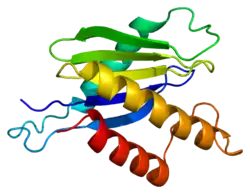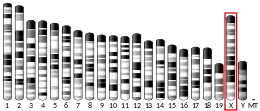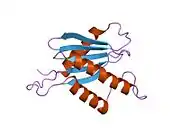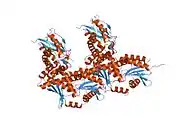| TRAPPC2 | |||||||||||||||||||||||||||||||||||||||||||||||||||
|---|---|---|---|---|---|---|---|---|---|---|---|---|---|---|---|---|---|---|---|---|---|---|---|---|---|---|---|---|---|---|---|---|---|---|---|---|---|---|---|---|---|---|---|---|---|---|---|---|---|---|---|
 | |||||||||||||||||||||||||||||||||||||||||||||||||||
| Identifiers | |||||||||||||||||||||||||||||||||||||||||||||||||||
| Aliases | TRAPPC2, MIP2A, SEDL, SEDT, TRAPPC2P1, TRS20, ZNF547L, hYP38334, trafficking protein particle complex 2, trafficking protein particle complex subunit 2 | ||||||||||||||||||||||||||||||||||||||||||||||||||
| External IDs | OMIM: 300202 MGI: 1913476 HomoloGene: 5436 GeneCards: TRAPPC2 | ||||||||||||||||||||||||||||||||||||||||||||||||||
| |||||||||||||||||||||||||||||||||||||||||||||||||||
| |||||||||||||||||||||||||||||||||||||||||||||||||||
| |||||||||||||||||||||||||||||||||||||||||||||||||||
| |||||||||||||||||||||||||||||||||||||||||||||||||||
| Wikidata | |||||||||||||||||||||||||||||||||||||||||||||||||||
| |||||||||||||||||||||||||||||||||||||||||||||||||||
Trafficking protein particle complex subunit 2 (TRAPPC2) also known as MBP-1-interacting protein 2A (MIP-2A) is a protein that in humans is encoded by the TRAPPC2 gene.[4][5] A processed pseudogene of this gene is located on chromosome 19, and other pseuodogenes of it are found on chromosome 8 and the Y chromosome. Two transcript variants encoding the same protein have been found for this gene.[5]
Function
Trafficking protein particle complex subunit 2 is thought to be part of a large multisubunit complex involved in the targeting and fusion of endoplasmic reticulum-to-Golgi transport vesicles with their acceptor compartment. In addition, the encoded protein can bind MBP1 and block its transcriptional repression capability.[5]
Genetic Location
The TRAPPC2 gene is located on the X-chromosome at position 22 between base-pairs 13,712,241 to 13,734,634.[6]
Clinical significance
Mutations in this gene are a cause of X-linked spondyloepiphyseal dysplasia tarda (SEDT).[5]
Interactions
TRAPPC2 has been shown to interact with Alpha-enolase[7] and CLIC1.[8]
References
- 1 2 3 GRCm38: Ensembl release 89: ENSMUSG00000079317 - Ensembl, May 2017
- ↑ "Human PubMed Reference:". National Center for Biotechnology Information, U.S. National Library of Medicine.
- ↑ "Mouse PubMed Reference:". National Center for Biotechnology Information, U.S. National Library of Medicine.
- ↑ Gécz J, Shaw MA, Bellon JR, de Barros Lopes M (November 2003). "Human wild-type SEDL protein functionally complements yeast Trs20p but some naturally occurring SEDL mutants do not". Gene. 320: 137–44. doi:10.1016/S0378-1119(03)00819-9. PMID 14597397.
- 1 2 3 4 "Entrez Gene: TRAPPC2 trafficking protein particle complex 2".
- ↑ "TRAPPC2 gene at Genetics Home Reference".
- ↑ Ghosh AK, Majumder M, Steele R, White RA, Ray RB (January 2001). "A novel 16-kilodalton cellular protein physically interacts with and antagonizes the functional activity of c-myc promoter-binding protein 1". Molecular and Cellular Biology. 21 (2): 655–62. doi:10.1128/MCB.21.2.655-662.2001. PMC 86643. PMID 11134351.
- ↑ Fan L, Yu W, Zhu X (April 2003). "Interaction of Sedlin with chloride intracellular channel proteins". FEBS Letters. 540 (1–3): 77–80. doi:10.1016/S0014-5793(03)00228-X. PMID 12681486. S2CID 8573651.
Further reading
- Shaw MA, Brunetti-Pierri N, Kádasi L, Kovácová V, Van Maldergem L, De Brasi D, et al. (September 2003). "Identification of three novel SEDL mutations, including mutation in the rare, non-canonical splice site of exon 4". Clinical Genetics. 64 (3): 235–42. doi:10.1034/j.1399-0004.2003.00132.x. PMID 12919139. S2CID 27897114.
- Adams MD, Soares MB, Kerlavage AR, Fields C, Venter JC (August 1993). "Rapid cDNA sequencing (expressed sequence tags) from a directionally cloned human infant brain cDNA library". Nature Genetics. 4 (4): 373–80. doi:10.1038/ng0893-373. PMID 8401585. S2CID 12612300.
- Bernard LE, Chitayat D, Weksberg R, Van Allen MI, Langlois S (May 1996). "Linkage analysis of two Canadian families segregating for X linked spondyloepiphyseal dysplasia". Journal of Medical Genetics. 33 (5): 432–4. doi:10.1136/jmg.33.5.432. PMC 1050619. PMID 8733060.
- Bonaldo MF, Lennon G, Soares MB (September 1996). "Normalization and subtraction: two approaches to facilitate gene discovery". Genome Research. 6 (9): 791–806. doi:10.1101/gr.6.9.791. PMID 8889548.
- Gedeon AK, Colley A, Jamieson R, Thompson EM, Rogers J, Sillence D, et al. (August 1999). "Identification of the gene (SEDL) causing X-linked spondyloepiphyseal dysplasia tarda". Nature Genetics. 22 (4): 400–4. doi:10.1038/11976. PMID 10431248. S2CID 5784112.
- Gécz J, Hillman MA, Gedeon AK, Cox TC, Baker E, Mulley JC (October 2000). "Gene structure and expression study of the SEDL gene for spondyloepiphyseal dysplasia tarda". Genomics. 69 (2): 242–51. doi:10.1006/geno.2000.6326. PMID 11031107.
- Ghosh AK, Majumder M, Steele R, White RA, Ray RB (January 2001). "A novel 16-kilodalton cellular protein physically interacts with and antagonizes the functional activity of c-myc promoter-binding protein 1". Molecular and Cellular Biology. 21 (2): 655–62. doi:10.1128/MCB.21.2.655-662.2001. PMC 86643. PMID 11134351.
- Gedeon AK, Tiller GE, Le Merrer M, Heuertz S, Tranebjaerg L, Chitayat D, et al. (June 2001). "The molecular basis of X-linked spondyloepiphyseal dysplasia tarda". American Journal of Human Genetics. 68 (6): 1386–97. doi:10.1086/320592. PMC 1226125. PMID 11349230.
- Grunebaum E, Arpaia E, MacKenzie JJ, Fitzpatrick J, Ray PN, Roifman CM (June 2001). "A missense mutation in the SEDL gene results in delayed onset of X linked spondyloepiphyseal dysplasia in a large pedigree". Journal of Medical Genetics. 38 (6): 409–11. doi:10.1136/jmg.38.6.409. PMC 1734897. PMID 11424925.
- Mumm S, Zhang X, Vacca M, D'Esposito M, Whyte MP (August 2001). "The sedlin gene for spondyloepiphyseal dysplasia tarda escapes X-inactivation and contains a non-canonical splice site". Gene. 273 (2): 285–93. doi:10.1016/S0378-1119(01)00571-6. PMID 11595175.
- Takahashi T, Takahashi I, Tsuchida S, Oyama K, Komatsu M, Saito H, Takada G (April 2002). "An SEDL gene mutation in a Japanese kindred of X-linked spondyloepiphyseal dysplasia tarda". Clinical Genetics. 61 (4): 319–20. doi:10.1034/j.1399-0004.2002.610416.x. PMID 12030902. S2CID 31600967.
- Fiedler J, Bittner M, Puhl W, Brenner RE (July 2002). "Mutations in the X-linked spondyloepiphyseal dysplasia tarda (SEDL) coding sequence are not a common cause of early primary osteoarthritis in men". Clinical Genetics. 62 (1): 94–5. doi:10.1034/j.1399-0004.2002.620114.x. PMID 12123495. S2CID 35441074.
- Gao C, Luo Q, Wang HL, Gao XQ, Fan QT, Wang H, et al. (February 2003). "[Identification of a novel mutation IVS2-2A-->C of SEDL gene in a Chinese family with X-linked spondyloepiphyseal dysplasia tarda]". Zhonghua Yi Xue Yi Chuan Xue Za Zhi = Zhonghua Yixue Yichuanxue Zazhi = Chinese Journal of Medical Genetics. 20 (1): 15–8. PMID 12579492.
- Xiao C, Zhang S, Wang J, Qiu W, Chi L, Li Y, Su Z (April 2003). "A single nucleotide deletion of 293delT in SEDL gene causing spondyloepiphyseal dysplasia tarda in a four-generation Chinese family". Mutation Research. 525 (1–2): 61–5. doi:10.1016/s0027-5107(02)00315-9. PMID 12650905.
- Fan L, Yu W, Zhu X (April 2003). "Interaction of Sedlin with chloride intracellular channel proteins". FEBS Letters. 540 (1–3): 77–80. doi:10.1016/S0014-5793(03)00228-X. PMID 12681486. S2CID 8573651.
- Savarirayan R, Thompson E, Gécz J (September 2003). "Spondyloepiphyseal dysplasia tarda (SEDL, MIM #313400)". European Journal of Human Genetics. 11 (9): 639–42. doi:10.1038/sj.ejhg.5201025. PMID 12939648.





